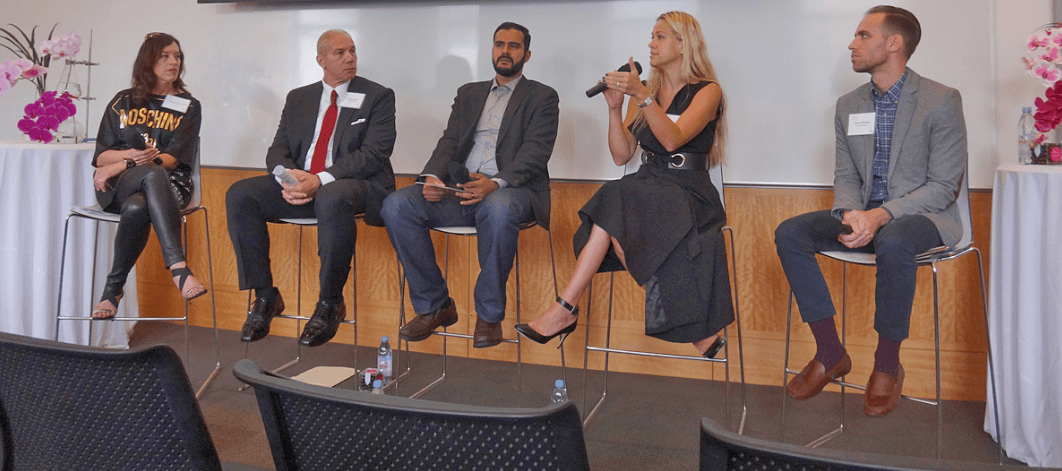What do rust, New York City and counterfeiters have in common? Apparently, none of them ever sleep! I attended the 8th Anniversary edition of the Fashion Law Institute’s NYFW seminar on Friday morning titled “Know Your Faux: New Tactics and Tech for Fighting Fakes.” The esteemed panel included Joseph Giblin, Foreign Service Officer, U.S. Department of State; Vidyuth Srinivasan, Co-Founder, and CEO, Entrupy; Catherine Malkova, Innovation Labs Leader, Global Business Services North America, IBM; and Derek Morales, Brand Protection Counsel, Ralph Lauren.
First, there was a continental breakfast which I thoroughly enjoyed al fresco on the terrace at the beautiful Fordham Law School. Next, the always effervescent Founder and Director of the Fashion Law Institute, Professor Susan Scafidi began the seminar remarking that this was a twenty year anniversary of sorts. “I officially started my research on the idea of a Fashion Law Institute in 1998,” said Scafidi, whom both dressed on theme and looked like a rock star in a Moschino “Authenticity Label” oversized black top with gold writing, leather leggings, and strappy stilettos.
 |
| Susan Scafidi |
What she had to say was serious business though. Did you know that $461 billion is the total global value of imported fake goods in 2013? Counterfeiters (yes, President Trump, they’re mostly from China) benefit from many of the technological advances we enjoy in the fashion industry such as the beaming of shows which enables them to see the designs (and copy them) that much faster.
How can technology help the problem? There are the four T’s: Tagging, Tracking, Testing, and Transparency. A brief explanation: Tagging would be something like what Madame Vionnet did using her thumbprint on her labels. Ways of weaving DNA markers into the fabric are currently being developed and employed. Tracking involves taking products through the supply chain and safeguarding their whereabouts at all times. Testing was discussed at length as Panelist Srinivasan’s company Entrupy has made inroads into developing an IOS-based solution that instantly identifies counterfeit goods using microscopic images. Transparency involves the sharing of information among government agencies, brands and others involved in the process of importing goods.
I also learned that there are three reasons not to buy that counterfeit handbag or jersey. For one thing, they can be poisonous! Anything that comes in contact with your skin can be dangerous — these goods are not regulated and can (and often do) use dyes that contain lead or other carcinogens. As if that’s not terrifying enough, how about the fact that you could be funding organized crime, terrorism, child labor or human trafficking since the profits of these black market goods support all of these endeavors. TOC (Transnational Organized Crime) has moved into this field. One panelist remarked off the record that heroin sales are less profitable than counterfeit goods! Lastly, if you buy that fake bag, you are undermining the U.S. economy and undermining brand holders as sales tax revenues are taken away.
Then there’s the problem of unknowingly buying counterfeit goods since fakes have gotten much harder to detect. “Fakes are getting better every day,” said Srinivasan “Their proliferation is getting ridiculous – even the legitimate supply chain is being compromised.” They are actually infiltrating brands at retail stores as goods are even passing muster as returns and could be resold to an unsuspecting consumer.
Morales at Ralph Lauren commented on “knowing versus unknowing purchase of counterfeits. “You could be buying sneakers at a trusted retailer, but they could still be counterfeit – no one thinks about that. Consumer education focuses on the knowing customer not the unknowing. Some trusted retailers don’t know that they have fakes coming into their supply chain.”
Malkova spoke about counterfeit jewelry concerns including an initiative called Trust Chain which is basically Block Chain with a “physical verification from mine to retail.” Richline has marketed six styles of engagement rings which are traced for authenticity and ethics to “avoid conflict diamonds and dirty gold.” Scafidi jokingly asked if that would be part of the engagement proposal.
Of course, fakes extend to other areas besides apparel, handbags, footwear, watches, and jewelry to toys, medical supplies and even machinery such as auto parts. “If you get a fake part in a nuclear submarine you’ve got a big problem on your hands,” remarked Giblin who supplied a website (https://www.iprcenter.gov) to report fakes. Gilbin also presented Scafidi with a special government issued commemorative coin to celebrate the Fashion Law Institutes 8th anniversary.
If you want to see something adorable checkout Professor Scafidi 2007 appearance on “How to Spot a Fake” on the Tyra Banks Show here: Warning: Try not to cringe when the real Gucci bag meets Tyra’s scissors!
As for as any last words of advice for consumers Srinivasan may have put it best: “Don’t trust but definitely verify!”
– Laurel Marcus


